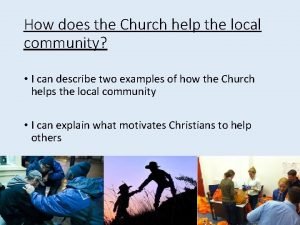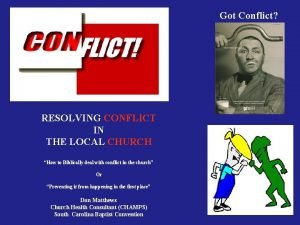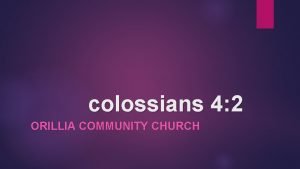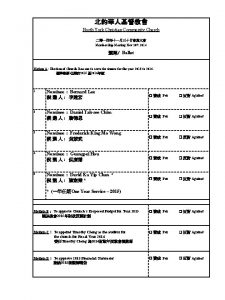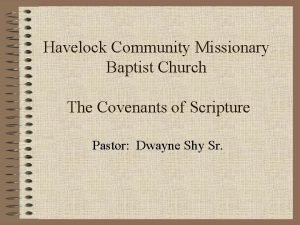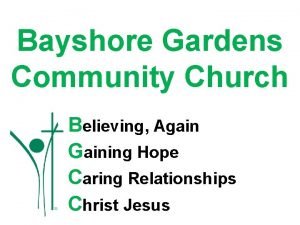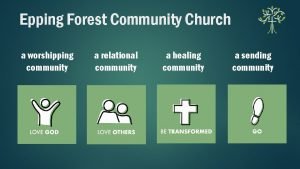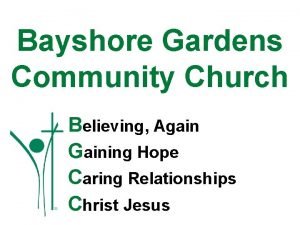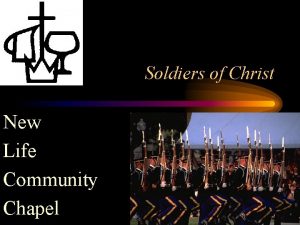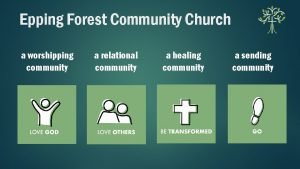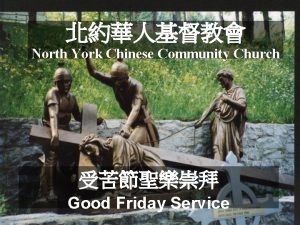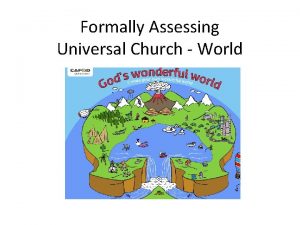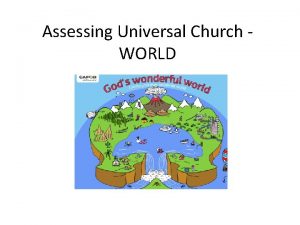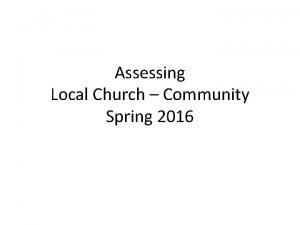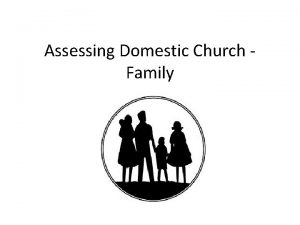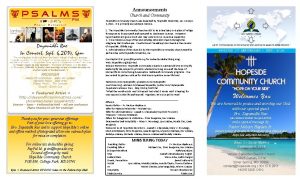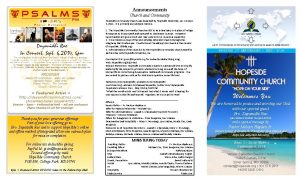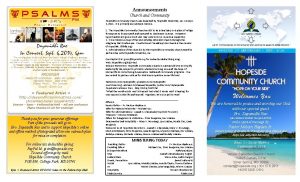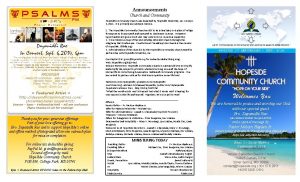Assessing Local Church Community Assessing Local ChurchCommunity This
















- Slides: 16

Assessing Local Church Community

Assessing Local Church/Community • This term, the formally assessed theme is the CHURCH THEME – Local Church / Community • We will be formally assessing AT 1 (i). The children may be informally assessed against the other strands. • Each year group will assess from an activity taken from a Learning Focus in Reveal. • The activities are listed over the next few slides. • When planning please leave this task out. • Please teach all of ‘Explore’, ‘Reveal’ (but not the task you will use for the formal assessment) then, after ‘Remember’, please formally assess using the activities indicated. • This enables the children to have had opportunity to work through the topic in full to inform their assessment.

ATTAINMENT TARGET 1 : Learning about Religion (i) beliefs, teachings and sources CHURCH THEME ii) celebration and ritual SACRAMENTAL THEME iii) social and moral practices and way of life AT 2 : Learning from Religion i) engagement with own and others’ beliefs and values ii) engagement with questions of meaning and purpose CHRISTIAN LIVING THEME 1 Recognise some religious stories Recognise some religious signs and symbols and use some religious words and phrases Recognise that people because of their religion act in a particular way Talk about their own experiences and feelings Say what they wonder about 2 Retell some special stories about religious events and people Use religious words and phrases to describe some religious actions and symbols Describe some ways in which religion is lived out by believers Ask and respond to questions about their own and others’ experiences and feelings Ask questions about what they and others wonder about and realise that some of these questions are difficult to answer 3 Make links between religious stories and beliefs Use a developing religious vocabulary to give reasons for religious actions and symbols Give reasons for certain actions by believers Make links to show feelings and beliefs affect their behaviour and that of others Compare their own and other people’s ideas about questions that are difficult to answer 4 Describe and show understanding of religious sources, beliefs, ideas, feelings and experiences; making links between them Use religious terms to show an understanding of different liturgies Show understanding of how religious belief shapes life Show an understanding of how own and others’ decisions are informed by beliefs and values Engage with and respond to questions of life in the light of religious teaching 5 Identify sources of religious belief and explain how distinctive religious beliefs arise Describe and explain the meaning and purpose of a variety of forms of worship Identify similarities and differences between peoples’ responses to social and moral issues because of their beliefs Explain what beliefs and values inspire and influence them and others Demonstrate how religious beliefs and teaching give some explanation of the purpose and meaning of human life

Formal Assessment Spring 2013 Local Church – Community Beliefs, Teachings and Sources Early Years: Nursery Focus 2 p 98, Continuous Provision Activity 1. ‘Invite the children to use figures or finger puppets to re-enact the story of Mary and Joseph taking Jesus to the Temple. ’ Towards L 1

Formal Assessment Spring 2013 Local Church – Community Beliefs, Teachings and Sources Year 1: Learning Focus 5, p 106, Activity 1 ‘Read God’s Story 3 p 63. Go over the key questions 2, 3 & 4. Make stick puppets of the special people in the story. Ask the pupils to name each of the people and recognise what they are doing. ’ Level 1

ATTAINMENT TARGET 1 : Learning about Religion (i) beliefs, teachings and sources CHURCH THEME 1 Recognise some religious stories The children at L 1 should recognise the story of the Presentation and related people. 2 Retell some special stories about religious events and people To achieve L 2, the child needs to retell the story of the Presentation, naming the people. Try to keep annotated photographs of the activity, as evidence, if possible.

Year 2: Based on Learning Focus 4 p 105, Activity 2 ‘Read God’s Story 3 p 80 – The Baptism of Jesus Ask the key questions again. Invite the children to produce storyboard sequencing the events of this story in words and pictures. ’ Level 2

ATTAINMENT TARGET 1 : Learning about Religion (i) beliefs, teachings and sources CHURCH THEME 1 Recognise some religious stories 2 Retell some special stories about religious events and people 3 Make links between religious stories and beliefs The children at L 2 should retell the story of the Baptism of Jesus and name all the characters and events To achieve L 3, the pupil needs to make links with Christian beliefs.

Year 3: Based on Learning Focus 4 p 105, Activity 3 ‘Using God’s Story 3 p 71, invite the children to create a ‘Guide for a person not of the Christian faith which retells the story of the Annunciation and makes links with the story and Christian beliefs. ’ Level 2 and 3

ATTAINMENT TARGET 1 : Learning about Religion (i) beliefs, teachings and sources CHURCH THEME Recognise some religious stories Retell some special stories about religious events and people Make links between religious stories and beliefs The children at L 2 should retell the story of the Annunciation naming all the characters and events. To achieve L 3, the pupil needs to also make links between the story of the Annunciation and Christian beliefs

Year 4: Based on Learning Focus 5 p 111, Activity 1 ‘Revisit the scripture from God’s Story 3, pages 90, 137 and 141 Invite the children to design a guide / pamphlet entitled, ‘We are Called’ which outlines ways in which we can live out the message within the Scripture readings. ’ Level 3

(i) beliefs, teachings and sources ATTAINMENT TARGET 1 : Learning about Religion CHURCH THEME 1 Recognise some religious stories 2 Retell some special stories about religious events and people 3 Make links between religious stories and beliefs 4 Describe and show understanding of religious sources, beliefs, ideas, feelings and experiences; making links between them The children, at Level 3, should be able to make links between scripture (Romans 12: 8 -11, Mark 3: 13 -19 and Acts 6: 2 -13) and the Christian belief that they are called to share in the mission of Jesus. To achieve Level 4, the children should describe and show an understanding of beliefs, ideas, feelings and experiences about Mission by connecting scripture passages to other sources e. g. Baptism, Ordination, prayers and hymns etc.

Year 5: Based on Learning Focus 2 p 105, Activity 1 Write a letter of application or ‘Wanted Poster’ to attract suitable people to share Jesus’ mission. Include ideas about Jesus’ mission and how they can be developed and continued today. Give examples that show which Christian beliefs/scripture have motivated them to apply. Level 3 / Level 4

(i) beliefs, teachings and sources CHURCH THEME 1 Recognise some religious stories 2 Retell some special stories about religious events and people 3 Make links between religious stories and beliefs 4 Describe and show understanding of religious sources, beliefs, ideas, feelings and experiences; making links between them 5 Identify sources of religious belief and explain how distinctive religious beliefs arise The children, at Level 3, should be able to make links between scripture studied and being called. To achieve Level 4, the child would have to describe and show further understanding of the actions of Christians including showing feelings, ideas and experiences around being called.

Year 6: Based on Learning Focus 6, p 123, Activity 2 ‘Pupils write a presentation, Power. Point or script explaining what Christians believe about the Bible. Pupils describe and show understanding of the Bible, the beliefs, ideas and feelings of Christians and make links between them. They are able to support their work with a range of both scriptural texts and other source material. ’ Level 4

(i) beliefs, teachings and sources CHURCH THEME 1 Recognise some religious stories 2 Retell some special stories about religious events and people 3 Make links between religious stories and beliefs 4 Describe and show understanding of religious sources, beliefs, ideas, feelings and experiences; making links between them 5 Identify sources of religious belief and explain how distinctive religious beliefs arise The children will describe and show an understanding of the Bible, the beliefs, the ideas and feelings of Christians and make links between them. In order to progress to Level 5 a pupil would need to further evidence and substantiate the Level 4 task by identifying further sources of scripture and Christian belief in order to explain distinctive beliefs and how they arose.
 How do churches help the local community
How do churches help the local community Managing conflice in the local church
Managing conflice in the local church Orillia community church
Orillia community church North york christian community church
North york christian community church New community church glen allen va
New community church glen allen va 4 spiritual laws
4 spiritual laws Bayshore gardens community church
Bayshore gardens community church Community connector
Community connector Epping forest community church
Epping forest community church Bayshore gardens community church
Bayshore gardens community church Soldiers for christ community church
Soldiers for christ community church Be sure of this i am with you always
Be sure of this i am with you always Orillia community church
Orillia community church North york chinese community church
North york chinese community church Two drawbacks of a think local act local
Two drawbacks of a think local act local A think local act local multicountry type of strategy
A think local act local multicountry type of strategy Local vertical local horizontal frame
Local vertical local horizontal frame
